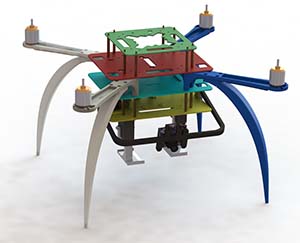Ford plans to unlock the full potential of drone-to-vehicle technology, to see the use of commercial drones as companion tools to vehicles so they can enhance people’s working lives, allowing them to get their jobs done more safely and efficiently.
 Ford is the only automaker on the Federal Aviation Administration’s (FAA) Rulemaking Committee, and a participant in the regulatory conversation around the integration of drones into civil aviation airspace.
Ford is the only automaker on the Federal Aviation Administration’s (FAA) Rulemaking Committee, and a participant in the regulatory conversation around the integration of drones into civil aviation airspace.
“At Ford, we are driving innovation in every part of our business to help make people’s lives better,” says Ken Washington, vice-president of research and advanced engineering, and chief technology officer at Ford. “And there is an opportunity to make a big difference with vehicles and drones working together for a common good.”
Representatives from Silicon Valley’s posse of Ford Motor Company’s Research and Advanced Engineering team attended the recent Unmanned Aircraft Systems (UAS) Symposium in Baltimore, Maryland.
Ford’s drone-to-vehicle technology would allow drone operators the convenience of being able to launch, fly, and dock drones from the safety and comfort of their vehicles on a job site. By accessing an app projected through Ford’s integrated SYNC 3 communications and entertainment system, the vehicle would serve as a mobile base station, facilitating a real-time link between the vehicle, the drone, and the cloud, so data could be shared. For quick and affordable inspection and monitoring, surveying and mapping, data collection and imaging, the scope for commercial applications of drone-to-vehicle technology is endless.
Here in South Africa, our commercial drone industry is rapidly expanding across all industries, including: agriculture and farming, mining, anti-poaching and wildlife protection, architecture and construction, media productions, sports and entertainment, journalism, telecommunications, traffic management, emergency response, search and rescue, law enforcement, military and national intelligence, private security, and more.
The South African Civil Aviation Authority (CAA) requires drone operators to be fully licensed before flying commercially. A Remote Pilot’s Licence (RPL) from a fully accredited CAA training academy, an Air Service Licence (ASL) from the Department of Transport, and a Remote Operator’s Certificate (ROC) from the CAA itself, are all non-negotiables.
“2018 is going to be the year of the drone in South Africa,” says Sean Reitz, CEO of United Drone Holdings, and the CAA-accredited RPAS Training Academy which educates and trains newcomers to the drone industry, whilst assisting to create employment opportunities.
But it’s far from a free-for-all. “While we do have comprehensive regulations regarding the use of commercial drones, they are considered highly restrictive, with only 22 ROCs issued by the CAA to date,” says Reitz. “There are several converging factors that will allow for growth and development of the commercial drone industry, with the most important one being the wider adoption of BVLOS (beyond visual line of sight) operations. This is where the real value of drones in South Africa will be demonstrated.”
And this is the exact issue that Ford has been tackling head on in the United States. Up till now, there wasn’t a way to identify and track drones in flight, BVLOS. Enter Ford colleagues John Luo and Adi Singh, manager of Emerging Technology Integration and Wireless Connectivity, and principal scientist of Unmanned Aerial Vehicle (UAV) Systems respectively. These brainiacs made a recent proposal to the FAA which could become a game changer.
“Every drone registered with the FAA is given a 10-digit number, which acts like a vehicle’s licence plate. Our patent-pending idea is to use the anti-collision lights on the drone to broadcast the drone’s unique number, to be captured and interpreted by a camera-based app we’ve developed. Our decoding algorithms can be run on a standard smartphone, which would enable anyone to identify and report a drone operating where it shouldn’t be, making it easier for aviation authorities to track rogue drones.”
It remains to be seen whether the FAA will adopt Luo and Singh’s recommendation. If they do, it could help lay the foundation for Ford realising its vision of making drone-to-vehicle technology available to the mainstream, which would benefit industries not just in the US, but worldwide.
This relentless pursuit of developing exciting new tech forms part of Ford’s plan to take the business to the next level – from leading automaker, to leader in connectivity, mobility, autonomous vehicles, the customer experience, as well as data and analytics.
